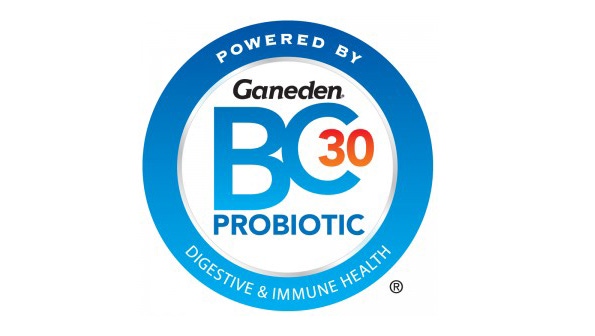December 31, 2015

 Cleveland, Ohio-based Ganeden Inc. has conducted probiotic research and product development since 1997, producing ingredients for animal health, cosmetics and, most notably, the functional food and beverage sector. Its GanedenBC30 (Bacillus coagulans GBI-30, 6086) is a patented, shelf-stable probiotic food additive now appearing in more than 125 food products worldwide. We spoke with Ganeden’s senior vice president—and International Probiotics Association president—Michael Bush about GanedenBC30’s remarkable growth in Asian markets and the company's next steps in global expansion.
Cleveland, Ohio-based Ganeden Inc. has conducted probiotic research and product development since 1997, producing ingredients for animal health, cosmetics and, most notably, the functional food and beverage sector. Its GanedenBC30 (Bacillus coagulans GBI-30, 6086) is a patented, shelf-stable probiotic food additive now appearing in more than 125 food products worldwide. We spoke with Ganeden’s senior vice president—and International Probiotics Association president—Michael Bush about GanedenBC30’s remarkable growth in Asian markets and the company's next steps in global expansion.
NBJ: What region is showing the greatest growth for Ganeden?
Bush: It continues to be the United States, but if you look at outside of the United States, the region with the greatest growth is Asia: Taiwan, Thailand, Japan, Indonesia, Singapore, they’re all growing pretty well—though we’re starting from a lower base.
NBJ: What’s going on there?
Bush: What we’ve found is that they’re very used to fermented foods and if they want to take a supplemental probiotic, they’re used to taking it in some sort of a fermented dairy type product or a supplement. As soon as we bring them a shelf-stable probiotic in a food product outside of the dairy case, they love it—especially considering that in many places in Asia dairy cases aren’t as readily available. The sell-through has been exceptional for the companies that have been launching with us.
NBJ: What are some of the formats?
Bush: We’ve done some little sachets that allow people to put the probiotic on top of their cereal or whatever it is they’re eating. We’ve had some gummy products that are actually more like fruit chews where they’re actually real fruit. It’s add-in type products where they’re adding the probiotic to whatever they want—or just staple foods—through a food additive. It seems like the Asian culture wants to have things in easy-to-use foods that they already consume.
NBJ: Is there a region that you see is slowing or plateauing?
Bush: Not really. Europe has plateaued for the last several years primarily due to what EFSA has done, outlawing the use of the term probiotic. That would be the area where we’re focusing the least because if you can’t say the word probiotic and you’re going to be launching a new product, it’s hard to explain to somebody that it’s probiotic.
NBJ: Have any of your client companies figured out a way to do that?
Bush: They just say that it contains GanedenBC30 cultures. You can say “cultures,” you can’t say “probiotic.” Or they’ll call it “the big drinkable yogurt," and Switzerland would call it a probiotic yogurt, probiotic drink or something. I forget what they call it, but now it’s called bifido drink or something like that. Or they just use the name of the bacteria as a descriptor for what the product is. We do know from the work that we’ve done at the IPA that the EFSA ban on probiotics has cost over a billion dollars in retail sales in the CPG companies.
NBJ: Is there a market that you expect to pop next for probiotics?
Bush: We see Latin America as the next frontier for us. We did a giant consumer survey last year in which we looked across multiple demographics at how people felt about probiotics and probiotic food and probiotic supplements and what format they would like to have their probiotics in. What we found was that Latin American people prefer to receive their functional ingredients in foods. We think that’s going to be a great market. As we roll more deeply into South and Central America, you’re going to see more and more activity in the staple food type of products.
NBJ: Is there a market that has a particular challenge for formulation to fit with their cultural food tradition?
Bush: Not really for us. What we do fits into a lot of foods. Last year we launched with Mission Tortilla, for example, a probiotic tortilla. For us, being that we’re a shelf-stable probiotic and that we can go into lots of food formats, it makes it easier. Most other organisms would be relegated to either dairy or supplement form so they wouldn’t be able to get into the standard foods.
NBJ: You feel like you have a big advantage, then?
Bush: Yes, we have a big competitive advantage as far as the South and Central American food market goes.
NBJ: Any surprises in international markets in 2015?
Bush: What we found that we didn’t expect was entrepreneurial companies that are able to grab hold of the concept and launch a product relatively quickly.
NBJ: They’re faster?
Bush: Yes, fast adoptions, but we were also surprised by how excited they were to have, in a lot of these Asian countries, an American-made ingredient that could be sold in Asia. We didn’t realize how important that was going to be to that market until we got into it.
NBJ: Are there any sort of trade barrier problems for you, particularly places like China that are notorious for that?
Bush: No. It is a complex regulatory environment—some of the regulatory dossiers that we’ve submitted have been literally 1,000-plus pages—but not real trade restrictions. It’s just that you have to go through the process of registering your ingredients, showing your safety, showing your efficacy work, and all that good stuff.
NBJ: What kind of growth are you seeing in Asia in general?
Bush: We doubled last year. Like I said, we’re starting from a lower base, but in Asia we doubled our business last year. Internationally in general, we’ve doubled in business.
NBJ: Is there a next functional foods frontier for probiotics, a food category where probiotics are not used now and is the next place for them?
Bush: We’ve invested a lot over the last couple years in sports nutrition protein—and protein beyond sports nutrition. If you look at the areas where protein is big you’ve got the active adult nutrition, you’ve got weight loss and a whole bunch of other areas where protein is just being pounded into the market. We’ve done a bunch of clinical work looking at protein metabolism, protein absorption, things like that, and sports performance. That market has taken off. We think that, for us, that’s the next place where things are really going to hit hard.
NBJ: Sports nutrition and probiotics is just becoming known here. Is that catching hold anywhere else internationally?
Bush: We have a product in Japan and then we have a couple in, I believe, the U.K. and Belgium.
NBJ: Here at home we have people talking about fermentation and sauerkraut and getting their probiotics that way. Is that anything for Ganeden to worry about—or even work with?
Bush: Fermented foods are great and they taste awesome and there are benefits, but if you think you’re getting all of your probiotic benefits from eating kimchi—well, you’d have to eat many, many pounds every single day. I don’t think people are really that committed to fermented foods.
NBJ: You said that in Asia where they’re used to fermented products it’s easier for you to sell probiotics. Do you also have to convince them that the foods are not enough?
Bush: I think it makes it easier. Because they’re used to the concept of the benefits of fermented foods, they’re used to the idea of probiotics. If you look at, for example, a company like Yakult, they do a ton of revenue in Japan and they deliver probiotic shots home by home. They literally deliver them to you. It’s opening up, but it’s also one of those things where the consumers are looking for something outside of those fermented beverages or fermented products. We think that culturally they’ve understood probiotics in Asia for many, many years. It just helps us.
NBJ: Fermented foods are more of a stepping stone than a barrier, then?
Bush: Correct. Exactly. It more opens up the opportunity than creates a barrier.
NBJ: What’s the biggest change you see in delivery formats?
Bush: I think that the primary thing is that if you look at the international market it’s very, very spoonable and drinkable yogurt-friendly. It is dominated by the yogurt industry—which not everybody wants to eat multiple times a day. It’s one of those things where supplement compliance is low, and compliance to eating yogurt on an everyday basis becomes lower and lower—especially when you look at Latin American countries or Asian countries where lactose intolerance may be more prevalent. We just think that the opportunity to add probiotics in general to non-yogurt or non-supplement products is really a huge opportunity and we’re excited to be participating in it.
You May Also Like



